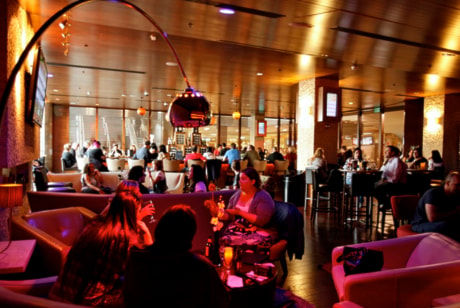Today, young movie-watchers look increasingly like Molly O’Connor. A junior at the University of Dallas, she still goes to the cinema occasionally, but is often just as happy to hunker down on a bed or a couch with friends to watch a downloaded movie on a laptop that’s perched on a nearby desk or a chair.
“Sometimes, it’s nice to have a wider screen, but I don’t think I gain that much by going to a movie theatre anymore,” the 20-year-old student says. “Now, it’s more about convenience.”
Or as 26-year-old Michael Brody puts it: “I watch movies the way many people listen to music — anytime, anywhere, any way.” A freelance writer in New York who blogs about film, he used to go to the movie theatre every week. Now he’s there once or twice a month, partly to save money and also because he doesn’t think most movies are worth the effort.
Sounds like bad news for movie theatres. But we’re talking about an industry that not only survived, but ended up thriving amid the arrival of television in the 1950s, videotapes in the 1980s, and DVDs in the ’90s.
The reason? An ability to continually remake themselves and find new ways to generate revenue, by introducing everything from the multiplex and more elaborate concessions to lengthy pre-show advertising.
Now they’re doing it again.
Step into some of the more modern cinemas, and you’ll see enticements aimed at keeping the lucrative youth market, even as online video becomes more accessible — or from pirates who steal and distribute movies illegally.
These upgraded theatres’ offerings begin with the super-comfortable seating, even lounge chairs and bean bags in some auditoriums. Add 3-D effects and larger-than-life IMAX blockbusters, made possible by new digital projectors. And then come the midnight premieres and opening-night parties.
To boost revenues and appeal, many theatres also are broadcasting live sporting events, operas and symphony performances and hosting in-theatre video game competitions on the big screen. Still others are opening in-house restaurants and bars for those old enough to drink alcohol.
It is this century’s answer to the movie palace of old — or the “Broadway-ification” of the moviegoing experience, as Charles Acland, professor of communications studies at Concordia University in Montreal, calls it.
“In a nutshell, what you’re going to see is cinema-going aimed at people who go less frequently,” says Acland, author of “Screen Traffic: Movies, Megaplexes and Global Culture.”
It might cost a bit more, he says. “But it will be much more of a special event. People will expect some sort of an experience that you can’t get anywhere else.”
In Europe, cinemas are taking it a step farther by remaking themselves as entertainment destinations — with bowling alleys, karaoke bars, comedy clubs and children’s play areas. Expect that here, too, as well as interior design schemes that appeal to the 18-to-24 set, and that might “dismay” the older crowd, says Toronto-based theatre architect David Mesbur.
He says lobbies of the newer theatres in his city — ones he didn’t design — are often mostly black with a few splashes of colour, flashing lights and loud music. Video games, often tucked away in theatres of old, also are scattered around in plain view.
“Those are the theatres that I never go to,” Mesbur says, chuckling.
Still, experts who track the movie industry say that, so far, all these kinds of efforts appear to be paying off.
Ticket sales this year are up, whether some of the popular movies have been Academy Award material or not.
“A bad or poorly received film can go down a bit easier if one is sitting in a comfortable reclining seat and has the chance to occasionally stretch their legs. In this sense, cinema-going has as much to do today with the hospitality industry as it does with the film industry, per se,” says Jeffrey Klenotic, associate professor of communication arts at the University of New Hampshire.
That’s a disheartening view to Ron Leone, a film and media studies professor at Stonehill College in Massachusetts. He looks around the audiences at the “uncomfortable, but nice” independent movie theatres he regularly attends, and sees few young faces.
“Apparently, watching the cat flushing the toilet is more satisfying,” he says, chuckling referring to a growing appetite for online videos. Those videos include anything from kitschy amateur pieces to the growing array of short and full-length films online.
That’s why more theatres are focusing on movies with special effects that don’t show well on a computer screen or in-home theatre and that are all but all but impossible for movie pirates to steal — and why major filmmakers such as Jeffrey Katzenberg and James Cameron are banking on 3-D and IMAX technology as the future of cinema.
So far, movie-goers have been more than willing to pay more to see movies in these special formats.
Earlier this month, Canadian-based IMAX Corp., maker of large-screen movie-theatre technology, reported a second-quarter profit with revenues nearly doubled. The company credited its growing cinema network, which includes about 250 theatres equipped to play Hollywood feature films in IMAX format, which uses digital technology to give what some call a notably richer visual experience, including 3-D.
